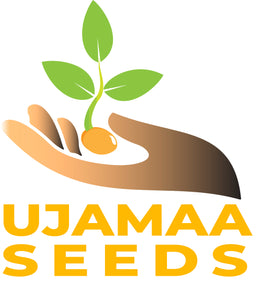Ultracross Okra
belmoschus esculentus
Seeds per packet ~ 30
Germination 64% Oct 2024 Packed for 2025
A composite cross of 85 varieties of okra. We are so excited to be able to offer Ultracross Okra seeds, the brainchild of our friend Chris Smith — author of the James Beard Award-winning The Whole Okra: A Seed to Stem Celebration — 'Ultracross' Okra is perhaps the most diverse okra composite cross ever made, but it is doubtless the most diverse okra population ever made available in one seed packet. We're eager to watch as the diversity of this population allows growers like you to develop new okra varieties and even expand the potential range of the crop.
Potential genetics represented in the mix include: 007; Alabama Red; Aunt Hettie's Red; Bear Creek Okra; Beardi; Big Red; Blondy; Bowling Red; Bradford Family Okra; Brandy Red; Bull Dog; Burgundy (aka Red Burgundy); Cajun Jewel; Candle Fire; Catawba Freesman - African Okra; Chatham Red Okra; Cherokee Long Pod; Choppee; Claude Lingerfelt Okra; Clemson Spineless; Dwarf Heirloom; Essoumtem Okra; French Quarter Pink; French Quarter Red; Granddaddy's Okra; Hill Country Red - Brian Harris; Hire Okra; Hitlers Okra; Hodnett Special Okra; Heavy Hitter; Hoopers Okra; Jimmy T's; Jing Orange; Kandahar Pendi; Kibbler Family Okra; Kon; Lahague; Langston Longhorn; Little Egypt; Louisiana Green Velvet; Louisiana 16" Long Pod; Moody Family Okra (A. caillei); Motherland Okra (A. caillei); Mr Bill Big Okra; No.76; Okinawa pink; Old Black Man's Okra; ORS 2833; ORS 2835; ORS 2844; ORS 2850; ORS 2851; ORS 2853; ORS 2854; ORS 2856; ORS 2860; ORS 2875; ORS 2896; ORS 2898; Puerto Rico Evergreen; Puerto Rico Evergreen Tall; Pusa Makhmali; Pusa Sawani; Quiabo #1; Quiabo #2; Quiabo #3; Rains Okra; Red Okra - Random; Red Okra 14; Red Okra 47; Red Okra 98; Red Pod 52; Red Velvet; Red Wonder; Salmon (F3); Shows Okra; Silver Queen; South Asian Okra; Stewart's Zeebest; Stubby Okra; Whidby White (?); Whidby White Improved; White Satin; Yalova Akkoy (aka Sultani); Yuma Red Okra.
Okra (Abelmoschus esculentus) has a perfect flower that easily self pollinates, but the hibiscus-like flower is also big and beautiful and okra patches can be filled with bees and wasps and a whole host of other pollinators (there is even an East Coast native ‘Okra Bee’, Ptilothrix bombiformis). All this means that okra will readily outcross, with promiscuity reported between 10% and 30% - in a closely planted, heavily insected field, outcrossing could be even higher. In 2021 The Utopian Seed Project planted 100 cultivars of Abelmoschus spp. within a 100ft x 25ft block. 83 of those cultivars were Abelmoschus esculentus (Common Okra) and there were 2 Abelmoschus caillei (West African Okra) that flowered. However, the chances of in-field interspecies crossing (A. esculentus x A. caillei) is pretty low. Either way, this mix of seeds represents massive genetic and varietal diversity.
Color: within this mix we have the whole range of okra pod color, from the palest greens (read: white) through to the dark reds and most things inbetween, including a good mix of green pods with red blushing.
Pod Shape: within this mix we have all the pod shapes represented in various combinations including, short, stubby, long, thin, chunky, deeply ridged, totally rounded, curly, and superlong.
Plant Height: we have everything from the 1-2 foot dwarf plants through to the 12ft + giants.
Country of Origin: many of these varieties are considered USA heirlooms. However there are also many Asian-origin okras in the mix as well as varieties that came directly from various African countries. Quiabo is of Brazilian origin.
We intend this mix of okra to be planted and enjoyed by a wide range of people. Perhaps you are an adventurous home gardener with limited space and really want the chance that every seed you plant could produce something different. Perhaps you are a Northern grower who struggles to get a good okra crop - this mix represents a great chance to plant out a large quantity of different genetics and save seeds from the healthiest survivors. Along the same lines of using this as the first step in a breeding population, you could select all the reds into a diverse red okra population, or all the short fat pods because you have a friend who likes stuffing okra, or the least spiny leaves for a green leaf production okra! The places each and every one of you could take this okra population are only limited by your imagination and we encourage you to select and save seeds based on your own needs and wants - even just saving seeds from the best plants will begin the process of regional adaptation, and preserving diversity will support the climate resilience of the crop.
Note: The genetics of these seeds will continue to shift and change over time. If your aim is to stabilize a single variety then this will be a multi-year project.
Note: By purchasing these seeds, you agree to never attempt to patent or otherwise restrict the use of these seeds or their descendants.











